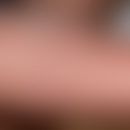Synonym(s)
Pregnancy dermatosis; Pruritic folliculitis of pregnancy
HistoryThis section has been translated automatically.
Zoberman 1981
DefinitionThis section has been translated automatically.
Intensely itchy pustular pregnancy dermatosis of the last trimester. The disease was first described in 1981 and is still controversial regarding its entity.
You might also be interested in
Occurrence/EpidemiologyThis section has been translated automatically.
Incidences are stated as 1 case of illness per 3,000 pregnancies.
EtiopathogenesisThis section has been translated automatically.
The cause is unclear. Hormonal imbalances have never been proven. Malassezia furfur was postulated as the trigger, but was rejected in several studies.
ManifestationThis section has been translated automatically.
Pruritic folliculitis of pregnancy typically develops in the second half of pregnancy and subsides spontaneously without leaving residuals 2-3 weeks post partum.
ClinicThis section has been translated automatically.
It describes a trunk and upper extremities accentuated, small focal, follicular, violently itchy exanthema, which can become pustular in places.
HistologyThis section has been translated automatically.
Pustular and non-pustular folliculitis.
DiagnosisThis section has been translated automatically.
Typical picture of an exanthema with follicular papules and pustules. The occurrence during pregnancy limits the differential diagnosis. Histology.
General therapyThis section has been translated automatically.
First, experiment with bland-free Lotio alba, ethanolic zinc oxide shaking mixture rp. 292, emulsions or gels. Active-ingredient-free cooling gels temporarily relieve itching rp. 039 . Cool showers, cool packs or moist compresses, e.g. with 0.9% NaCL solution, also have a soothing effect. If not sufficient, apply tannin 3-5% in lotio alba or external agents containing menthol or polidocanol (e.g. rp. 158 , rp. 200 , rp. 197 , Optiderm). The next step is glucocorticoid-containing emulsions (e.g. hydrogals, rp. 123 ) or 0.5% hydrocortisone cream (119). Furthermore, narrow band spectrum UVB was successfully applied.
Internal therapyThis section has been translated automatically.
The administration of antihistamines during pregnancy is assessed differently in the literature. For severe itching, 1st generation preparations such as clemastine (e.g. Tavegil 2 times/day 1 tbl. p.o. or 2 times/day 1 amp. i.v.) or hydroxyzine (e.g. Atarax 1-3 tbl./day) may be considered.
Progression/forecastThis section has been translated automatically.
Some case reports mention developmental disorders (lower birth weight) of the child. This has not been confirmed in other studies.
LiteratureThis section has been translated automatically.
- Kroumpouzos G (2005) Pityrosporum folliculitis during pregnancy is not pruritic folliculitis of pregnancy. J Am Acad Dermatol 53:1098-1099
- Masood S et al (2012)Frequency and clinical variants of specific dermatoses in third trimester of pregnancy: a study from a tertiary care centre. J Pak Med Assoc 62:244-248
- Parlak AH et al (2005) Pityrosporum folliculitis during pregnancy: a possible cause of pruritic folliculitis of pregnancy. J Am Acad Dermatol 52:528-529
- Reed J et al (1999) Pruritic folliculitis of pregnancy treated with narrowband (TL-01) ultraviolet B phototherapy. Br J Dermatol 141:177-179
- Zoberman E (1981) Pruritic folliculitis of pregnancy. Arch Dermatol 117:20-22.
Disclaimer
Please ask your physician for a reliable diagnosis. This website is only meant as a reference.




